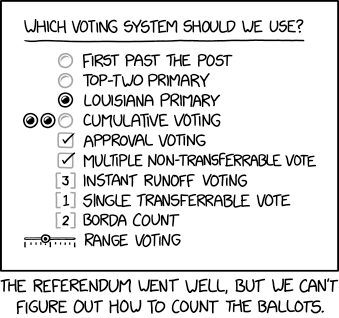In 2002, San Francisco approved instant runoff voting (IRV) for local elections and began implementing the system in 2004. Cities such as Oakland, Minneapolis, Santa Fe, and (most recently, in 2019) New York City have followed. In 2018, Maine became the first state to use IRV, also known as ranked-choice voting, in state and federal offices. In 2019, the Libertarian Party of Kentucky took credit for the defeat of incumbent governor Matt Bevin and used the occasion to promote IRV/RCV.
If you believe Arrow’s impossibility theorem, we can’t really come up with a perfect voting system. Every system fitting certain criteria (which means, effectively, any system we might try) is going to be vulnerable to strategic voting (or gaming the system). We can sometimes choose who wins by choosing the candidate.
My proposal for a voting system is a modified version of IRV. If the Democratic presidential debates have shown us something, it is that it is annoying to deal with large fields. Having to rank fourteen candidates gets awkward. IRV works best when limited to a number of candidates that can comfortably fit on a debate stage. I think that might be four or five candidates.
So, my proposal would be a two-round system: an initial voting round to create a shortlist of viable candidates, followed by a second round using IRV to determine a winner. I am open to suggestions on how to conduct that first round. For a Congressional race, it is probably sufficient to throw everyone into a single primary the way California does it. For the presidency, you might need something more complicated.
